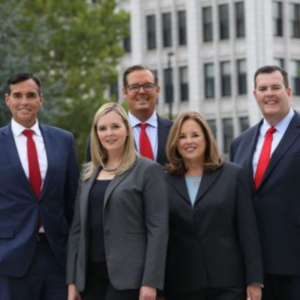How to Prove a Distracted Driver Caused Your Car Crash
Every year, thousands of lives are changed when drivers take their attention off the road. Whether it’s a glance at a text message or a moment spent adjusting the radio, these seemingly minor distractions can lead to devastating accidents. At Munley Law, we’ve seen firsthand how these split-second decisions impact families across Pennsylvania.
Proving that another driver’s distraction caused your accident isn’t always straightforward. While you might know the other driver was texting or eating behind the wheel, establishing this fact legally requires specific evidence and careful documentation.
If you’ve been injured in an accident caused by a distracted driver, call the experienced car accident attorneys at Munley Law. We understand what it takes to build a strong case. Contact us today for a free consultation, and let us help you get the compensation you deserve for your injuries and damages.
What Is Distracted Driving?
Distracted driving occurs when a driver engages in any activity that diverts their attention from operating their vehicle safely. Many drivers engage in common distracted behaviors daily, such as responding to text messages, eating breakfast during the morning commute, applying makeup in the rearview mirror, or adjusting the car’s temperature controls.
The National Highway Traffic Safety Administration (NHTSA) reports that distracted driving accidents claim thousands of lives annually, with many more suffering serious injuries. Even if a driver’s attention is off the road for five seconds while traveling at highway speeds, they cover the length of an entire football field, essentially driving blind.
 The human brain cannot multitask; instead, it rapidly switches between tasks. While driving, this task-switching creates dangerous gaps in attention and slows reaction time. A driver checking their phone might miss a child darting into the street or fail to notice brake lights ahead until it’s too late to stop safely. Even hands-free phone conversations reduce a driver’s ability to process and respond to visual information on the road.
The human brain cannot multitask; instead, it rapidly switches between tasks. While driving, this task-switching creates dangerous gaps in attention and slows reaction time. A driver checking their phone might miss a child darting into the street or fail to notice brake lights ahead until it’s too late to stop safely. Even hands-free phone conversations reduce a driver’s ability to process and respond to visual information on the road.
Many drivers underestimate the impact of distractions on their driving ability. They might believe they can safely send a quick text or change the radio station while driving, but research shows these activities significantly increase the risk of motor vehicle crashes. The reality is that any activity pulling attention away from driving creates unnecessary danger for everyone on the road.
Common Types of Distracted Driving
Distraction while driving takes three main forms, each presenting different types of dangers. Manual distractions occur when drivers remove their hands from the wheel. Examples include reaching for items in the passenger seat, typing addresses into a GPS, or holding food and drinks. These activities leave drivers unable to respond quickly to sudden road hazards or make emergency maneuvers.
 Visual distractions pull a driver’s eyes away from the road. Using the phone while driving, checking GPS directions, or watching roadside events are visual distractions. Drivers might think a glance at their phone is harmless, but those brief moments without visual awareness of traffic conditions often lead to accidents.
Visual distractions pull a driver’s eyes away from the road. Using the phone while driving, checking GPS directions, or watching roadside events are visual distractions. Drivers might think a glance at their phone is harmless, but those brief moments without visual awareness of traffic conditions often lead to accidents.
Cognitive distractions occur when a driver’s mind wanders from the task of driving. This can happen during intense phone conversations, while planning the day, or when dealing with strong emotions. Even with hands on the wheel and eyes on the road, a mentally distracted driver processes information more slowly and misses important visual cues in traffic.
Evidence to Prove Distracted Driving
Building a strong case against a distracted driver requires collecting various forms of evidence. Police reports often contain valuable information about the accident scene. They may note if the responding officer observed signs of distraction, such as phones being used or food containers on the driver’s lap.
 Witness accounts provide powerful evidence in distracted driving cases. Other drivers, passengers, or pedestrians might have noticed the at-fault driver using their phone or engaging in other distracting behaviors before the crash. Their testimonies can establish a pattern of distracted behavior leading up to the accident.
Witness accounts provide powerful evidence in distracted driving cases. Other drivers, passengers, or pedestrians might have noticed the at-fault driver using their phone or engaging in other distracting behaviors before the crash. Their testimonies can establish a pattern of distracted behavior leading up to the accident.
Cell phone records often provide concrete evidence of distraction. These records can show a driver’s cell phone use at the time of the crash. Video footage from traffic cameras, nearby security systems, or dashboard cameras might capture the distracted behavior directly. Additionally, social media activity around the time of the crash can reveal whether a driver posted or engaged online while driving.
Physical evidence at the crash scene tells its own story. Open food containers, scattered makeup items, or a phone thrown during impact can indicate what distracted the driver. This evidence, combined with skid marks and vehicle damage patterns, helps reconstruct the sequence of events that led to the accident.
Steps to Take After an Accident with a Distracted Driver
Your immediate actions after a distracted driver car accident can strengthen your case. First, ensure everyone’s safety by moving to a secure location and calling emergency services. Seek medical care even if you feel fine, as some injuries take time to become apparent.
Document everything at the accident scene. Take photos of vehicle damage, road conditions, and any visible distractions in the other driver’s vehicle. Gather contact information from witnesses who saw the crash and the events leading up to it. Their observations might prove invaluable later.
When speaking with law enforcement, provide a clear account of what happened and mention any distracted behavior you noticed. Request a copy of the police report for your records. Keep detailed notes about the accident while your memory is fresh, including weather conditions, traffic patterns, and the other driver’s behavior before and after the crash.
How a Car Accident Attorney Can Help Prove Distracted Driving
 Personal injury attorneys have access to resources and methods that can help uncover evidence of distracted driving that might otherwise remain hidden.
Personal injury attorneys have access to resources and methods that can help uncover evidence of distracted driving that might otherwise remain hidden.
- Your car accident lawyer will subpoena phone records and obtain surveillance footage
- Expert witnesses play a key role in these cases.
- Reconstruction specialists analyze physical evidence and crash data to show how the accident occurred.
- Cell phone forensics experts can retrieve deleted messages or app activity that might prove a distraction.
Insurance companies often resist paying full compensation in distracted driving cases. An experienced attorney knows how to counter their tactics and present evidence effectively. If settlement negotiations fail, your attorney can take your case to court, presenting evidence and arguing your right to fair compensation.
The Challenges of Proving Distracted Driving
Without direct evidence, such as phone records or video footage, proving distraction becomes more challenging. Drivers rarely admit to being distracted, often providing alternative explanations for the crash. They might claim they were paying attention or blame other factors for the accident.
Even when witnesses are present, their recollections may be unclear or inconsistent, and they may conflict with one another. Surveillance footage isn’t always available, and phone records may not tell the complete story of what happened in the moments leading up to the crash.
Get Expert Legal Help for Your Distracted Driving Case
The team at Munley Law understands the complexities of distracted driving cases. We’ve helped numerous clients secure compensation after accidents caused by distracted drivers. Our experience with these cases means we know where to look for evidence and how to build compelling arguments for our clients.
If you’ve been hurt by a distracted driver, contact Munley Law today for a free case review. We’ll examine your situation and develop a strategy to seek the compensation you deserve. Don’t let a distracted driver’s poor choices derail your life; reach out to our team and take the first step toward recovery.

Marion Munley
Marion Munley is recognized for her compassionate representation of catastrophically injured clients and her steadfast dedication to them and their families. Her advocacy has produced numerous multimillion-dollar recoveries, including one of the largest trucking accident settlements on record. Marion is Triple Board Certified by the National Board of Trial Advocacy in Civil Trial, Civil Practice, and Truck Law, and since 2023 has been named one of Pennsylvania’s Top 10 Super Lawyers by Super Lawyers.
Posted in Car Accidents.









